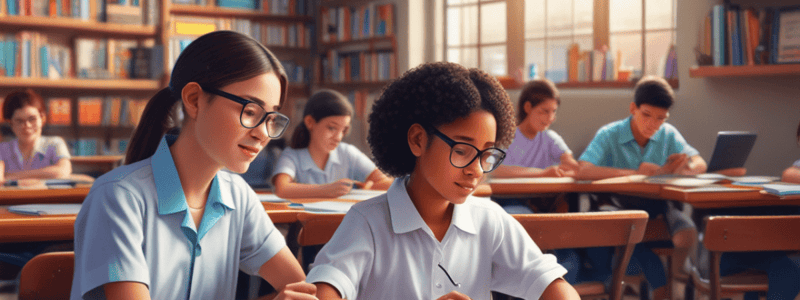Podcast
Questions and Answers
What is the relationship between teacher efficacy and student learning?
What is the relationship between teacher efficacy and student learning?
- The relationship is reciprocal, where teacher efficacy and student learning benefit each other. (correct)
- The relationship is unidirectional, where teacher efficacy affects student learning but not vice versa.
- The relationship is complex, with both positive and negative effects depending on the specific circumstances.
- The relationship is negative, as higher teacher efficacy can lead to overestimating student abilities.
What does the text suggest about the role of self-regulation in teaching?
What does the text suggest about the role of self-regulation in teaching?
- Self-regulation is a necessary skill for teachers to help students become self-regulated learners. (correct)
- Self-regulation is not important for teaching, as it is more relevant for students.
- Self-regulation is a complex skill that teachers should focus on developing in themselves and their students.
- Self-regulation is a skill that teachers can develop over time, but it is not a major goal of teaching.
What does the text suggest about the relationship between teacher efficacy and the 'day-to-day tasks' of teaching?
What does the text suggest about the relationship between teacher efficacy and the 'day-to-day tasks' of teaching?
- Teacher efficacy is not directly related to day-to-day teaching tasks, as it is more influenced by student learning outcomes.
- Teacher efficacy is a fixed trait that is not influenced by the daily tasks of teaching.
- Teacher efficacy grows from the success of teaching with 'real' day-to-day tasks. (correct)
- Teacher efficacy is not affected by day-to-day teaching tasks, as it is more influenced by long-term factors.
What does the text suggest about the role of 'problems' in developing teacher efficacy?
What does the text suggest about the role of 'problems' in developing teacher efficacy?
What does the text suggest about the role of 'optimism' in teacher efficacy?
What does the text suggest about the role of 'optimism' in teacher efficacy?
What does the text suggest about the role of 'student abilities' in teacher efficacy?
What does the text suggest about the role of 'student abilities' in teacher efficacy?
What does the text suggest about the role of 'teaching experience' in developing teacher efficacy?
What does the text suggest about the role of 'teaching experience' in developing teacher efficacy?
What is the relationship between teacher efficacy and 'student learning'?
What is the relationship between teacher efficacy and 'student learning'?
What is the main benefit of involving students in evaluating their own learning?
What is the main benefit of involving students in evaluating their own learning?
According to Turner & Paris, what can increase when students anticipate successful outcomes?
According to Turner & Paris, what can increase when students anticipate successful outcomes?
What is a key aspect of involving students in making choices and decisions about their learning tasks?
What is a key aspect of involving students in making choices and decisions about their learning tasks?
Which factor is predicted by theories of cognitive and social activities to improve when students engage in self-regulation?
Which factor is predicted by theories of cognitive and social activities to improve when students engage in self-regulation?
How do students benefit from being involved in setting goals and planning their learning activities according to Ryan & Deci?
How do students benefit from being involved in setting goals and planning their learning activities according to Ryan & Deci?
Which aspect of students' learning is affected by giving them responsibility for evaluating their own control?
Which aspect of students' learning is affected by giving them responsibility for evaluating their own control?
What is an expected outcome when students anticipate successful work?
What is an expected outcome when students anticipate successful work?
What was Lynn's primary difficulty?
What was Lynn's primary difficulty?
What does the text suggest about Lynn's motivation for writing?
What does the text suggest about Lynn's motivation for writing?
What was the primary goal of the writing projects Lynn assigned to her students?
What was the primary goal of the writing projects Lynn assigned to her students?
Based on the information provided, which of the following best describes Lynn's approach to teaching writing?
Based on the information provided, which of the following best describes Lynn's approach to teaching writing?
Which of the following best describes the relationship between Lynn and her colleague Carol Drummond?
Which of the following best describes the relationship between Lynn and her colleague Carol Drummond?
What was Lynn's approach to assigning writing projects to her students?
What was Lynn's approach to assigning writing projects to her students?
Based on the information provided, which of the following best describes the content of Lynn's writing instruction?
Based on the information provided, which of the following best describes the content of Lynn's writing instruction?
What was Lynn's primary concern or challenge as a writing teacher?
What was Lynn's primary concern or challenge as a writing teacher?
Which of the following is NOT mentioned as an emotion that students can develop in the early years?
Which of the following is NOT mentioned as an emotion that students can develop in the early years?
Which of the following is TRUE about the relationship between self-regulation and achievement?
Which of the following is TRUE about the relationship between self-regulation and achievement?
Which of the following is NOT mentioned as an aspect of self-regulation in the text?
Which of the following is NOT mentioned as an aspect of self-regulation in the text?
Which of the following is TRUE about the relationship between emotional self-regulation and teaching effectiveness?
Which of the following is TRUE about the relationship between emotional self-regulation and teaching effectiveness?
Which of the following is NOT mentioned as a factor related to student achievement?
Which of the following is NOT mentioned as a factor related to student achievement?
Which of the following is TRUE about the relationship between emotional self-regulation and burnout, according to the text?
Which of the following is TRUE about the relationship between emotional self-regulation and burnout, according to the text?
Which of the following groups is NOT mentioned as being interested in research on self-regulation and teaching effectiveness?
Which of the following groups is NOT mentioned as being interested in research on self-regulation and teaching effectiveness?
What is the primary focus of the text?
What is the primary focus of the text?
What is the primary focus of the text?
What is the primary focus of the text?
What is a key challenge that Tracy faces in her learning, according to the text?
What is a key challenge that Tracy faces in her learning, according to the text?
Which of the following is NOT mentioned as a component of the self-regulated learning model described in the text?
Which of the following is NOT mentioned as a component of the self-regulated learning model described in the text?
What strategy does the text suggest Tracy could use to improve her self-regulated learning?
What strategy does the text suggest Tracy could use to improve her self-regulated learning?
What is the purpose of the self-regulated learning model described in the text?
What is the purpose of the self-regulated learning model described in the text?
What is a key difference between Tracy's approach to studying and the self-regulated learning model?
What is a key difference between Tracy's approach to studying and the self-regulated learning model?
What does the text suggest about the relationship between self-efficacy and self-regulated learning?
What does the text suggest about the relationship between self-efficacy and self-regulated learning?
What is the primary purpose of the self-evaluative phase in the self-regulated learning model described in the text?
What is the primary purpose of the self-evaluative phase in the self-regulated learning model described in the text?
Flashcards are hidden until you start studying




